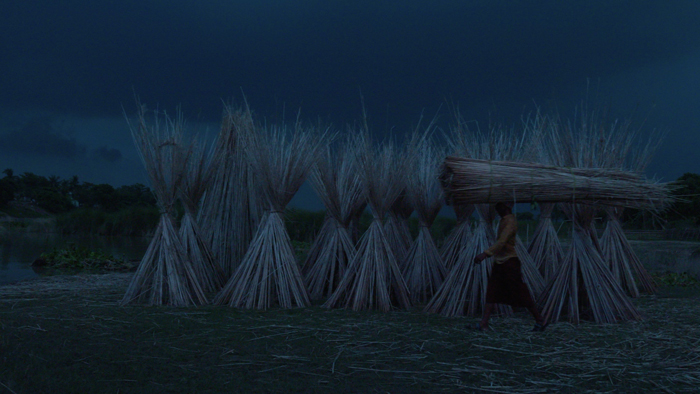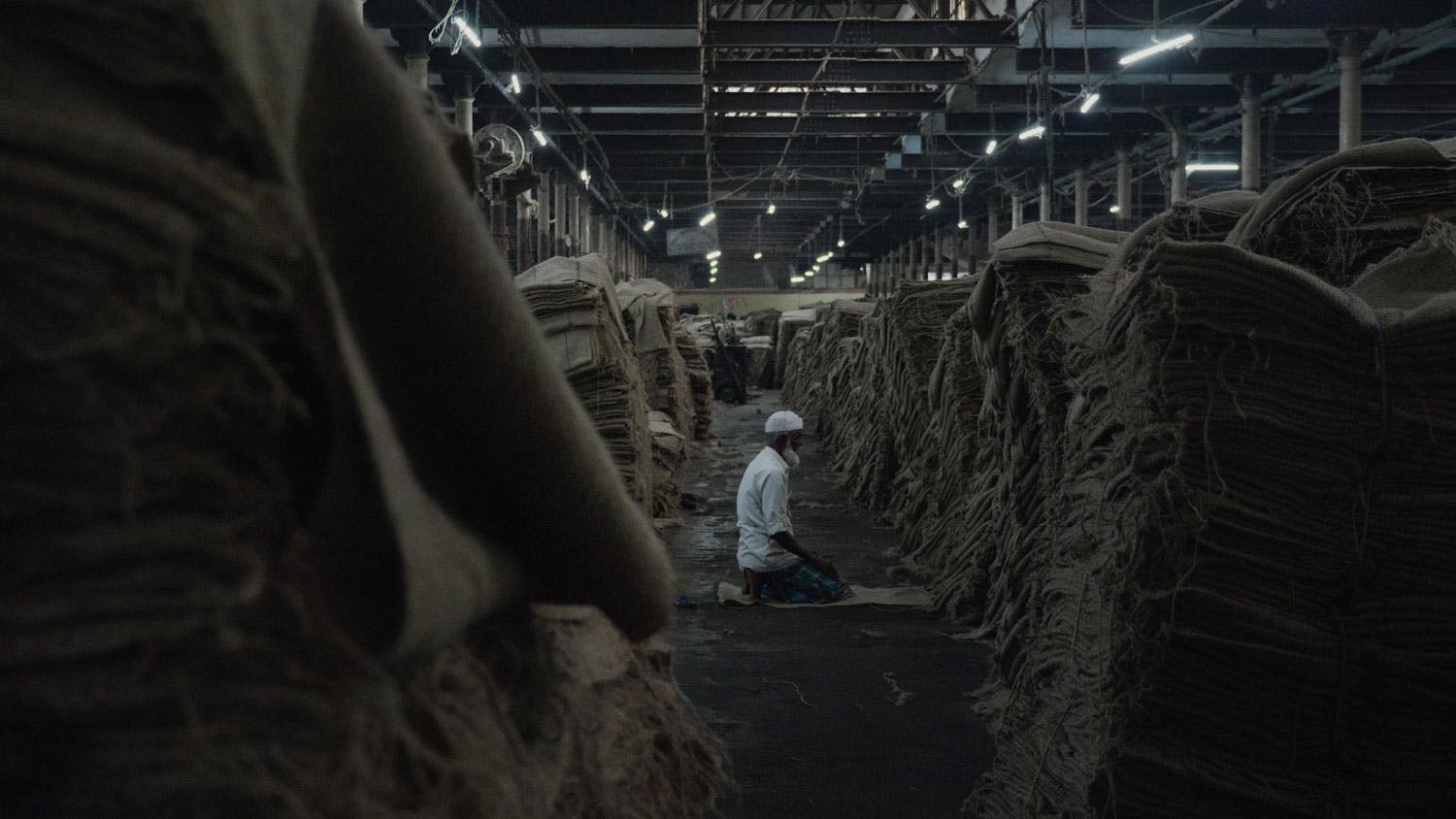New Film is a Symphonic Ode to Manual Labour
Documentary about India’s jute factories immerses viewers in a natural-fibre industry on the cusp of transformation.
A worker kneels down to pray on the factory floor of Kolkata’s Hukumchand Jute Mill.
The first 16 minutes of the documentary film The Golden Thread are wordlessly magical. Long takes show workers on their bicycles, machines at Kolkata’s Hukumchand Jute Mill operating in rhythmic unison, a worker’s hand skillfully guiding golden-coloured threads, accompanied by a soundtrack of chirping birds, clicking bicycle spokes, a wailing shift-start siren, whirring machines. The viewer is invited into this world and asked to take it all in. No explanation is required or offered.
“Somebody called this film a symphony of jute and I think that’s so true,” says director Nishtha Jain, on the phone from Paris where she’s working on her next project. The word “jute” refers to both a variety of reed-like plants that thrive in humid weather and to the natural fibre derived from those plants. It has been an important crop in South Asia—especially Bengal—for millennia. Today, jute is primarily used to make packaging textiles like burlap. It is known as “the golden fibre” because of its colour and economic value.
From the factory floor where the fibre is processed, the viewer is transported to a West Bengal jute field where a farmer is busy cutting down reeds of the plant. Crickets chirp in the background, a soft breeze rustles, everything in rhythm.
“I am looking at how manual labour is soon going to be a thing of the past because of being replaced by automation,” says Jain. “So, in this particular sequence, just looking at this person working at something that is backbreaking is also a meditative experience. It’s such skillful work, almost like a dance. So I like to give these little things time, things which we don’t really have the time for in our daily lives.”

The Golden Thread will be screened as part of the DOXA Documentary Film Festival’s Thin Places programming—a collection of films described by the festival as “exploring liminal and precarious zones.” Mills like Hukumchand—which was built more than 100 years ago—were designed to be expansive, sunlit spaces, where workers park their bicycles and store their lunch boxes. Spaces Jain says were imbued with a homey-ness lacking in modern factories.
“Most of this ambience is gone now,” she says. “It’s only in India that somehow, you know, old things live longer in a way because everywhere else the turnaround is much faster. It’s because of a certain culture of repairs and reuse that a lot of the past kind of rolls into the present.”
Jute is being called “the fabric of the future” because of its environmentally friendly qualities.
India has long been one of the leading global producers and exporters of jute. The state of West Bengal, where the crop is primarily harvested, was once considered the hub of the jute industry. Then came the plastic revolution of the ‘60s and jute lost its lustre. For mill workers, these changing circumstances have often meant low wages and exploitation.
Fast-forward to today, and jute is being called “the fabric of the future” because of its environmentally friendly qualities, like sturdiness and biodegradability. Jute products are in demand from eco-friendly businesses. In 2022, India manufactured over 1 million metric tonnes of jute goods, with West Bengal the leading producer. But even with this demand, new automated looms would cut factories’ labour force by half.
“There’s been a lot of scientific work that has happened in terms of the utilization of jute in many other forms,” says Jain. “So it is making a kind of a comeback, but still it’s quite a struggle.”
Documenting the lives of workers is a familiar theme for Jain. Her past work includes Lakshmi and Me (2007) about a domestic worker in Mumbai and At My Doorstep (2009) focused on the city’s migrant labourers: garbage collectors, security guards, and delivery boys. But she approached making The Golden Thread differently, not wanting it to be about just one thing. “When a film about workers is made, the first theme that jumps out is exploitation,” says Jain. “But I wanted to focus on broader topics. This factory is a place where dreams are made and broken.”
Historically, jute mills provided housing known as “labour lines,” that would be passed between generations of workers. For older generations, the mills and surrounding communities where they began their lives and livelihoods instilled a sense of pride and belonging. Maqsood Alam, who has worked at Hukumchand since 1965, speaks emotionally in the film about how the mill is the source of workers’ sustenance, “just as farmers sow and harvest grain that feeds their families.” He’s among numerous workers voicing concern about the shutting down or modernization of these mills.

However, the documentary also shows younger generations who are less enthusiastic about working at a job that these days offers little in terms of compensation and long-term benefits. Pulkit Singh—a teen who celebrates his birthday in the film—is blunt about why he would opt for a career working for “Defence” (by which he could mean policing or India’s armed forces) over the mill.
“Other jobs need us to study a lot,” he says. “We need to do specialisation and advanced courses. Who is going to pay for those specialised, advanced courses? My father’s an ordinary mill worker, and higher studies need money.”
I’m looking at labourers as part of an ecosystem like jute is part of an ecosystem.
Jain points out that though youngsters who leave the protective environs of their mill town might earn a bit extra in another city, the payoff isn’t enough. Migrants end up living in claustrophobic conditions, sometimes five people to a room to save on rent. And being away from family takes a toll on their mental well-being, as can harsher working conditions.
“In these factories and mills like Hukumchand, they get long lunch breaks,” she says. “But in modern setups you’re not even allowed time to go pee.”
“With this film,” Jain elaborates, “I’m looking at labourers as part of an ecosystem like jute is part of an ecosystem. How when you destroy one thing—in replacing jute with plastic and therefore harming the jute industry as well as the environment—you’re destroying an entire ecosystem. Today, even though there is talk about the environment, there is not enough talk about human labour itself. And that, I think, is an important concern, because … human beings are also part of that environment.”
Vancouver’s DOXA Documentary Film Festival runs from May 4–14, 2023. The Golden Thread (91 min) screens in person on May 10 at 6:15 pm, at The Cinematheque. Tickets are available on the DOXA website.
